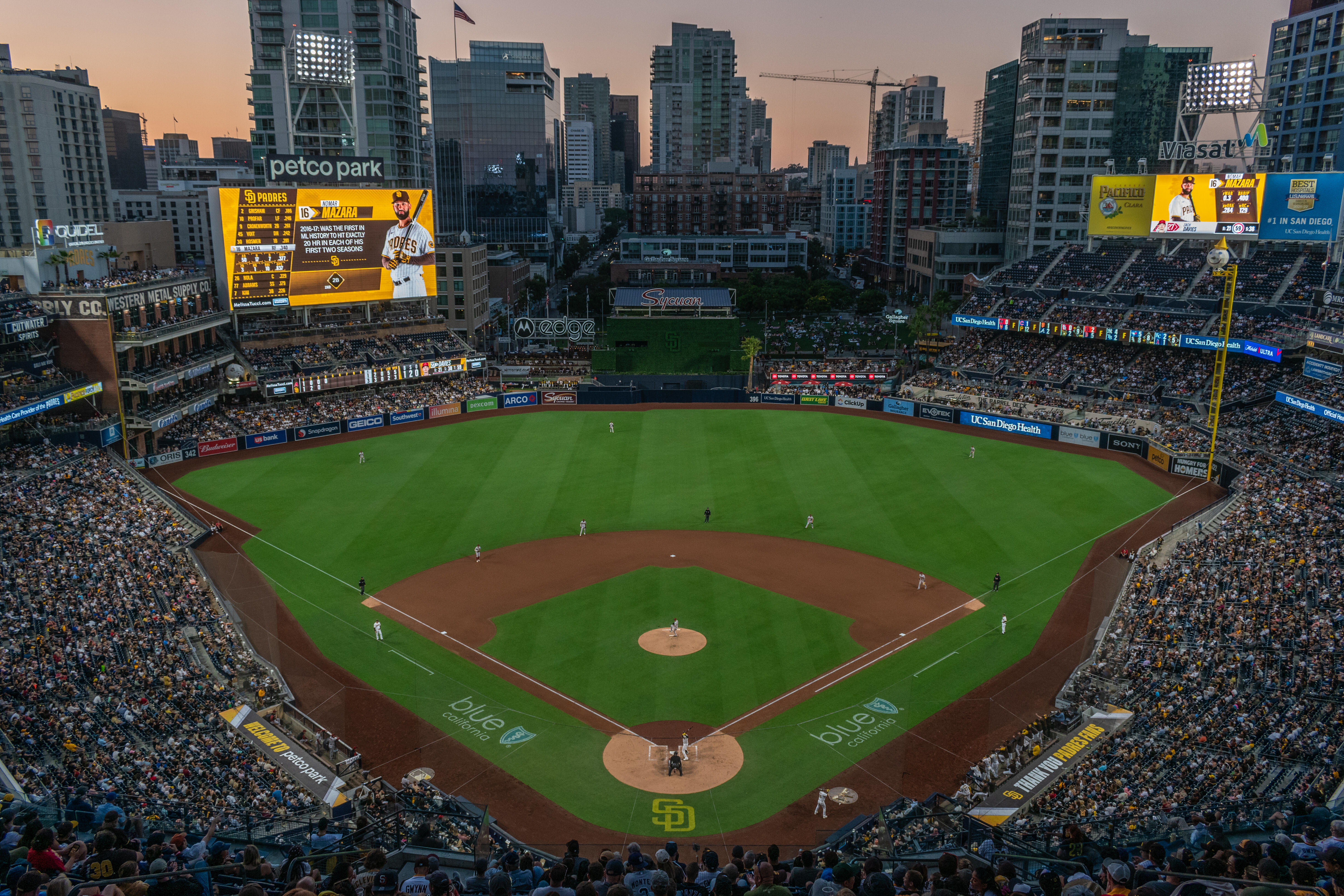BUY THIS PHOTO AS A PRINT OR CANVAS >
📍 San Diego, California
⚾ Home of the San Diego Padres
The story of professional baseball in America’s Finest City dates back to 1936, when the minor league Hollywood Stars moved down the California coast to become the San Diego Padres. By 1969, the Padres – named in honor of the Franciscan friars who founded the city in the 18th century – had clinched four league titles and moved up to Triple-A. Meanwhile, the population of San Diego had more than tripled, and the blossoming region was subsequently granted an expansion franchise by Major League Baseball. The Padres name was transferred to the new National League club, who played at San Diego Stadium until 2003. That venue had many names, including Jack Murphy Stadium and Qualcomm Stadium, but was ultimately replaced by one of MLB’s finest ballparks – Petco Park.

BUY THIS PHOTO AS A PRINT OR CANVAS >
Opened in 2004, Petco Park seats 40,000 fans and is suitably nestled into San Diego’s busy Gaslamp Quarter. The orientation of the park allows for unobstructed views of the downtown skyline in the outfield, and of San Diego Bay beyond the third base seating structure. Unlike many of its peers, Petco Park was designed to be a uniquely San Diego stadium, something that’s overwhelmingly evident in its architecture and design. The stucco and sandstone facade of the ballpark helps it to blend in with the beige cliffs and beaches located nearby, while the deep blue seats represent the Padres’ former primary color and reminds fans of beautiful coastline that’s just steps away. Long, twisted ivy also hangs from many of the walkways and support structures located throughout the stadium, as well as featuring prominently on the batter’s eye in center field.
The iconic Western Metal Supply Building in left field adds even more character to the already exemplary ballpark vibe. Although initially scheduled to be demolished in 2004 to accommodate the construction of Petco, it was thankfully preserved and incorporated into the ballpark footprint. Today, the century-old building houses a team store, restaurant, rooftop bleachers and even suites.

Located right next to the Western Metal Supply Building is the Padres Hall of Fame, which commemorates big moments from seasons past and has lots of Friars memorabilia on display. This modest space highlights the region’s rich baseball history as well and touches on the club’s minor league roots, including an exhibit on Ted Williams, a San Diego native who played for the Double-A Padres in 1936. Just outside the museum is a wall that immortalizes Padres greats that have been inducted into the Baseball Hall of Fame in Cooperstown.
Back inside the Western Metal building is the Breitbard Hall of Fame, yet another history spot that honors those who have left their mark on the San Diego sports scene. Accomplished athletes who have either lived in San Diego or played for a local team are distinguished here with a plaque memorializing their achievements.
Highway to the Danger Zone
The San Diego area is home to numerous military bases and is the home port of much of the Navy’s Pacific Fleet. One of these installations – MCAS Miramar – was even home to the “Top Gun” program, the inspiration for the hit 1986 movie of the same name.
In 1996, in recognition of the military presence in the city, the Padres became the first professional sports team to host an annual armed forces appreciation event. Since then, the team has worn uniforms honoring the military on many occasions throughout the course of each season.

In many MLB markets, it’s the ballpark itself that is a part of the cityscape; in San Diego, it’s the city that is a part of the ballpark.
In deep center field, there’s a decent-sized sandbox where kids – or kids at heart – can experience the sandy beaches of SoCal without ever leaving the stadium. Also, true to its longstanding Naval history, the Padres sound a ship whistle – that of the USS Ronald Reagan, to be exact – after every home run and win.
When you’re at a ballpark like Citi Field in New York or Truist Park in Atlanta, it’s easy to imagine that you really could be anywhere. The same cannot be said about Petco Park. As you take in a Padres game on a cool California evening, the breeze comes off the bay and causes the palm trees to sway, and you just can’t help but remember that this is America’s Finest City.
Info Invasion
Must Eat: Churros, a ballpark and SoCal classic!
Parking: Plentiful garages just a short walk away in downtown
Nearby Venue(s): Snapdragon Stadium, Viejas Arena
In the Area: Dive into San Diego’s naval history at the USS Midway Museum


Leave a Comment